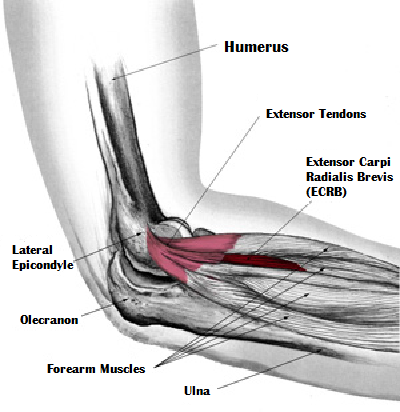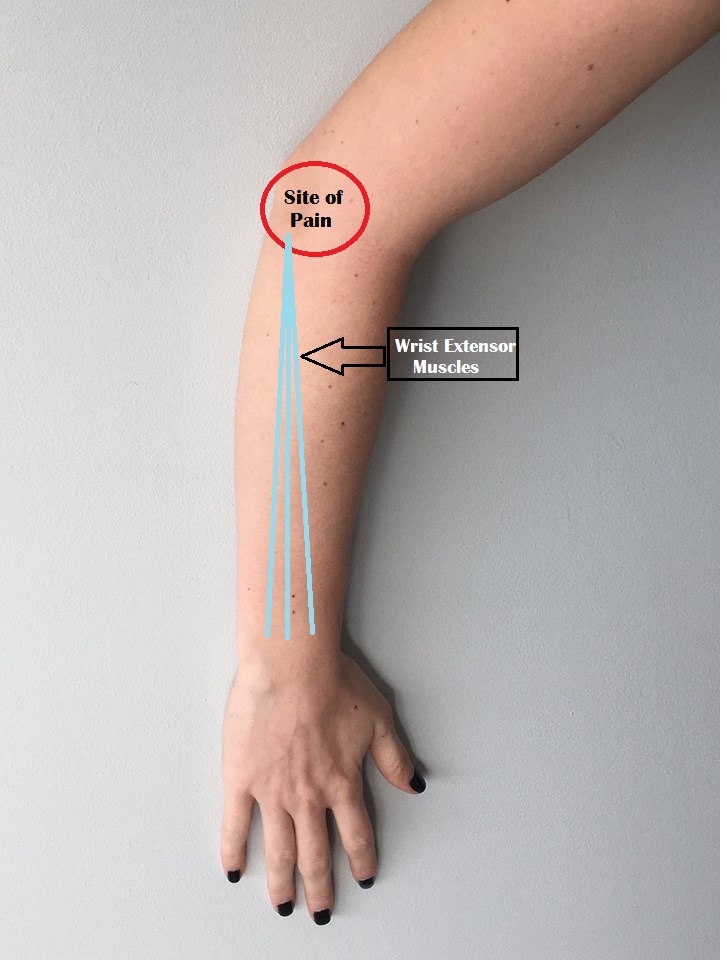Now that it is the end of the outdoor golf and tennis season, here at Glen Abbey Physiotherapy in Oakville we tend to see our fair share of elbow related injuries. Although we may see fractures, dislocations, sprains, strains and nerve related injuries from these sports, there is one type of condition we provide physiotherapy for more than any other impairment. This is the famous Tennis Elbow Syndrome, also known as lateral epicondylitis. In today’s blog post our Oakville physiotherapist will be going over how this injury comes to be, differential diagnoses of this condition, signs and symptoms along with treatment and management techniques of this condition.
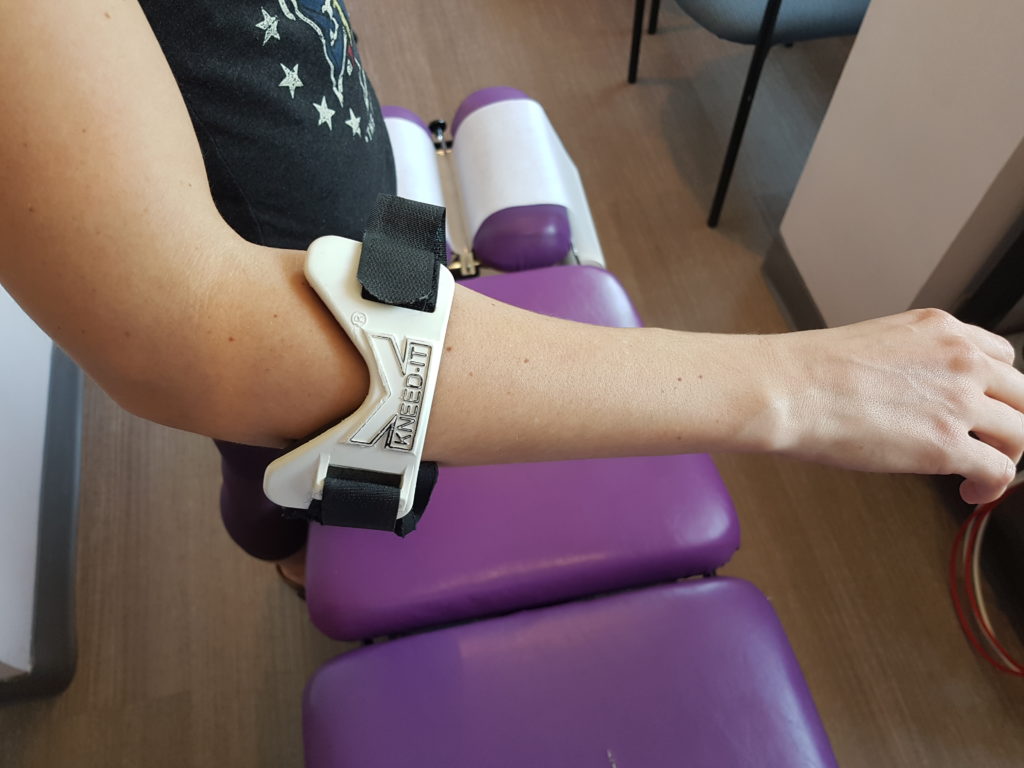
Where Does Tennis Elbow Come From?
So what exactly is tennis elbow? It may be defined as a lesion affecting the tendinous origin of the wrist extensor. It is the most common overuse syndrome in the elbow affecting the lateral forearm muscles, which originate from the epicondyle of the distal humerus. The condition was first recognized as a clinical entity over a century ago and was originally called ‘lawn tennis arm’ by Mr. Morris. Some synonymous terms that you may hear your physiotherapist or medical doctor state are lateral epicondylitis, lateral stress syndrome, periostitis of extensor attachment, musculo-tendinous junction strain and nipping of synovial fringe at the elbow. All these terms essentially mean the same injury has occurred; just different terms depending on the health care professional’s formal education and training. The most common name ‘tennis elbow’, does not give the injury justice, as only 5-10% of individuals suffering from tennis elbow relate the injury to tennis. You don’t have to be Bianca Andreescu to develop this condition. Therefore, a full detailed physiotherapy assessment done by your therapist at Glen Abbey Physiotherapy would be warranted to corrected diagnose your elbow pain.
Learn more About Tennis Elbow Here
Is Tennis Elbow Common?
The incidence of tennis elbow affects roughly 3% of Canada’s population. That would be roughly 1 million Canadian’s are affected by this impairment each year. It is the most common tendinitis, both males and females are equally affected, most commonly occurs between the age of 40-60, rarely occurs under the age of 20, usually affects the dominant arm and has a higher incidence in novice tennis players with poor load management. The etiology of the condition is from repeated minor trauma, overuse, eccentric overload (meaning the wrist is loaded while it is bending forward/flexing) decreased flexibility of the forearm extensors, faulty equipment, faulty stroke mechanics, inadequate grip strength, inadequate forearm extensor strength, repetitive movements, heavy lifting, vibration forces and repetitive twisting and turning of the wrist known as supination and pronation (this is the motion used to open or close a door knob).
Although the condition is only seen 5% of the time in tennis players among all patients at Glen Abbey Physiotherapy, of the active tennis players out there, roughly 35-40% of them will be inflicted by tennis elbow some point in their careers. Contributing factors of the condition are experience and ability of the player, increased stress if the player continually misses the ‘sweet spot’ on the racquet, poor stroke techniques, inadequate power, flexibility or endurance, heavier, stiffer racquets increase stress of the lateral forearm muscles, handle size too large or too small for the athlete, the racquet is strung too tightly (remember that gut stringing is more resilient then nylon), dead or wet balls increase load and stress and hard playing surfaces increase stress and load. These are all factors that can be adjusted for the recreational and competitive tennis player during their racquet season.
Read More About Lateral Epicondylitis
Tennis Elbow Anatomy
So what exactly is the clinically relevant anatomy of this condition?
Your elbow joint is made up your radius, ulna and humerus; these three bones are the immediate surface of the overlying muscle tissues. Along the most distal and lateral part of the humerus (your arm bone) is a ridged surface known as the lateral epicondyle. From here, the majority of your wrist extensor musculature originates from here allowing you to extend your wrist backwards, straighten your elbow or help open up your palm. The most common muscle is the extensor carpi radialis brevis, also known as ECRB. This muscle usually affects 90% of all tennis elbow related diagnoses. The second most common muscle in tennis elbow syndromes is the extensor carpi radialis brevis muscle tendon junction which is just a few fingers breaths inferior/below the main muscle insertion along the lateral epicondylitis of your ECRB. Beyond these two muscle points, 2% o all over tennis elbow syndromes arise from the extensor carpi radialis longus and extensor carpi ulnaris, both muscles originating near your ECRB muscle.
How Will I Know If I Have Tennis Elbow?
Do not get to hung up on the confusion of which muscle, tendon and junction is most affected, let that be managed by your physiotherapist as Glen Abbey
Physiotherapy. However, it is important that you recognize the signs and symptoms of the condition so you know when to see your physiotherapist. The condition is usually an insidious onset, symptoms tend to become progressively worse, the lateral elbow pain often radiates down the lateral forearm to the wrist or dorsum of the hand or upwards along the lateral arm, occasionally the long and ring fingers also ache, the is tenderness over or in front of the lateral epicondyle, painful weakness of the wrist extensors, pain on extending the elbow with your forearm pronated (palm facing down), difficulty gripping, muscle atrophy (loss) if longstanding, rarely limited range of motion of the wrist and elbow, night time pain and pain with use and stretching.
Conditions That May Masquerade As Tennis Elbow
Although you may be certain you have a tennis elbow based on the above description of the condition, do make sure to visit with your Glen Abbey Physiotherapist, as there are many conditions, which may present like this condition. Just to name a few: cervical spondylosis, osteoarthritis, radial tunnel syndrome, double crush syndrome, bony spur, lateral ligament sprain, supinator strain, supracondylar fracture, quadrate ligament sprain, fractures radial head, lateral epicondyle epiphysis separation, posterior interosseus syndrome, cervical radiculopathy, cervical myofascial pain etc. Yes, there are a lot of differential diagnoses and different management techniques for each, so although Google may try diagnosing your injury with you, make sure to see your physiotherapist to diagnose the correct condition of your impairment.
Tennis Elbow Physiotherapy Treatment
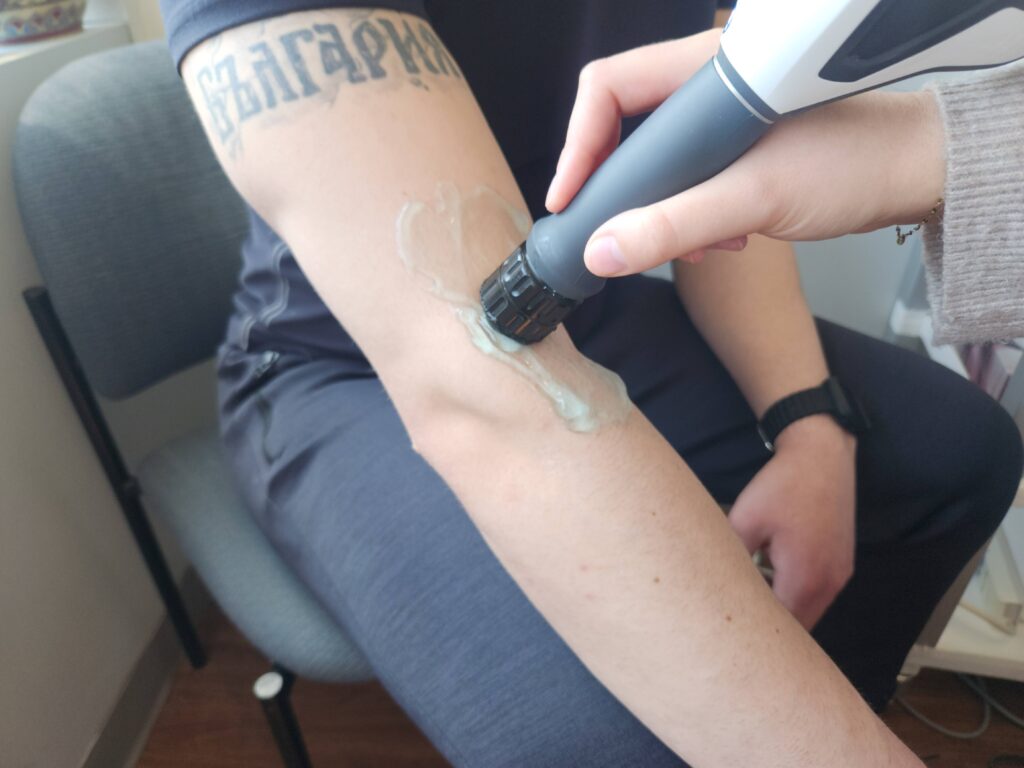 What can you expect as treatment at Glen Abbey Physiotherapy for your Tennis Elbow Syndrome? We conduct a detailed assessment of the elbow and diagnose it correctly. From there we will teach you the appropriate exercises, guide you with patient education, knowledge of bracing, ice, heat, management techniques and positions to stay away from for a period of time to help you heal. Here in clinic, we will perform soft tissue mobilizations, soft tissue release, deep tendon friction, shockwave treatment, acupuncture if warranted, IFC, isometric strengthening exercises, stretching techniques, thermal agents, cryotherapy, ultra-sound, unloading taping techniques and more to help you on your way to recovery.
What can you expect as treatment at Glen Abbey Physiotherapy for your Tennis Elbow Syndrome? We conduct a detailed assessment of the elbow and diagnose it correctly. From there we will teach you the appropriate exercises, guide you with patient education, knowledge of bracing, ice, heat, management techniques and positions to stay away from for a period of time to help you heal. Here in clinic, we will perform soft tissue mobilizations, soft tissue release, deep tendon friction, shockwave treatment, acupuncture if warranted, IFC, isometric strengthening exercises, stretching techniques, thermal agents, cryotherapy, ultra-sound, unloading taping techniques and more to help you on your way to recovery.
Learn About Recommended Exercises and Home Care
While working with your physiotherapist at Glen Abbey Physiotherapy, we will guide you in the right direction to recovery and get you back to your normal daily living, whether its hitting backhands on the tennis court, lifting heavier objects at work, typing at your computer, or just opening door knobs and handles within your home, we are here to provide you the road to recovery. We will help educate you about other medical treatment and diagnostic imaging if required by your medical doctor also. So you can feel that your family physician is always in the loop of your physiotherapy intervention and treatment. If you or someone you know is having lateral elbow pain, come stop by Glen abbey Physiotherapy in Oakville and we would be happy to help rid that pain and get you back to the activities you love.
Learn More About Tennis Elbow Treatment
Acupuncture For Tennis Elbow
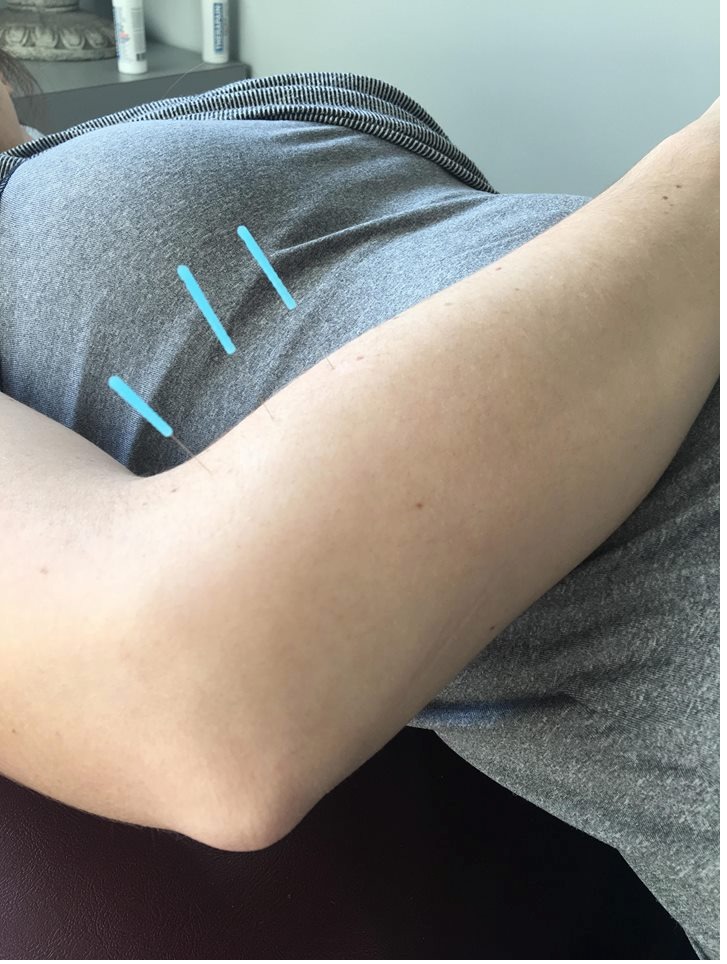 The contemporary medical acupuncture practiced at the clinic involves the insertion of fine needles through the skin at specific points to help stimulate the nerves and kick-start the healing process. While acupuncture is an excellent treatment option for most conditions, it is especially helpful for tennis elbow. This condition typically responds very well to acupuncture treatment, and using acupuncture in conjunction with physiotherapy will help the elbow feel better extremely quickly! Whether your tennis elbow is in the acute stage (only been sore for a few weeks) or it’s moved into the chronic stage (been bothering you for longer than 3 months) acupuncture is an effective treatment option. The needles help to clear inflammation in the acute stages, and help amplify the healing response in chronic stages.
The contemporary medical acupuncture practiced at the clinic involves the insertion of fine needles through the skin at specific points to help stimulate the nerves and kick-start the healing process. While acupuncture is an excellent treatment option for most conditions, it is especially helpful for tennis elbow. This condition typically responds very well to acupuncture treatment, and using acupuncture in conjunction with physiotherapy will help the elbow feel better extremely quickly! Whether your tennis elbow is in the acute stage (only been sore for a few weeks) or it’s moved into the chronic stage (been bothering you for longer than 3 months) acupuncture is an effective treatment option. The needles help to clear inflammation in the acute stages, and help amplify the healing response in chronic stages.
The treatment only requires using a few needles. The maximum number of needles used in a tennis elbow treatment is 4. Needles will be inserted into the elbow, forearm and hand to stimulate the nerve responsible for innervating the muscles that are causing the problem with tennis elbow. Acupuncture is a safe and effective treatment method. If you’re wondering if acupuncture can help you, visit the clinic and ask Dr. Jenn today!
